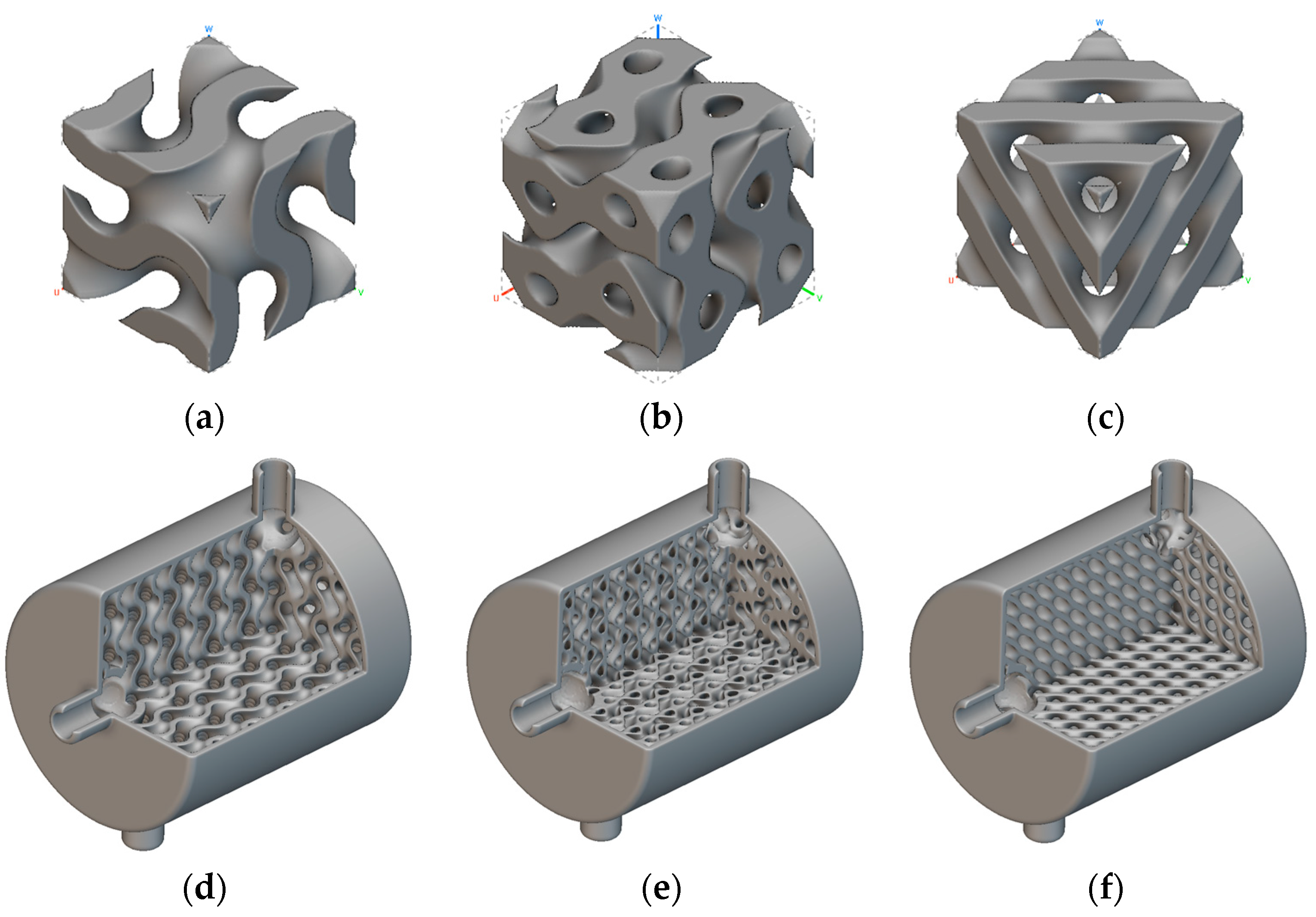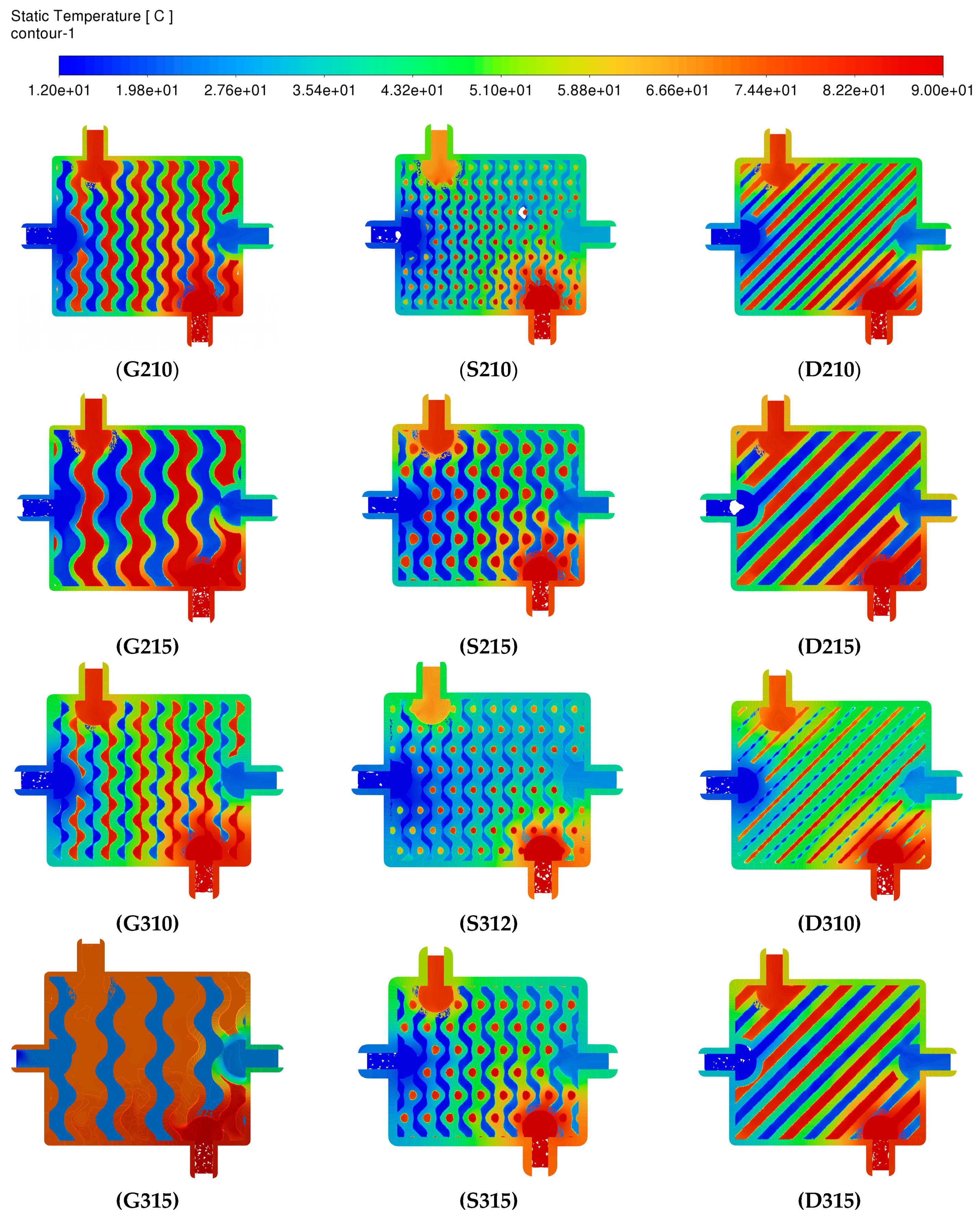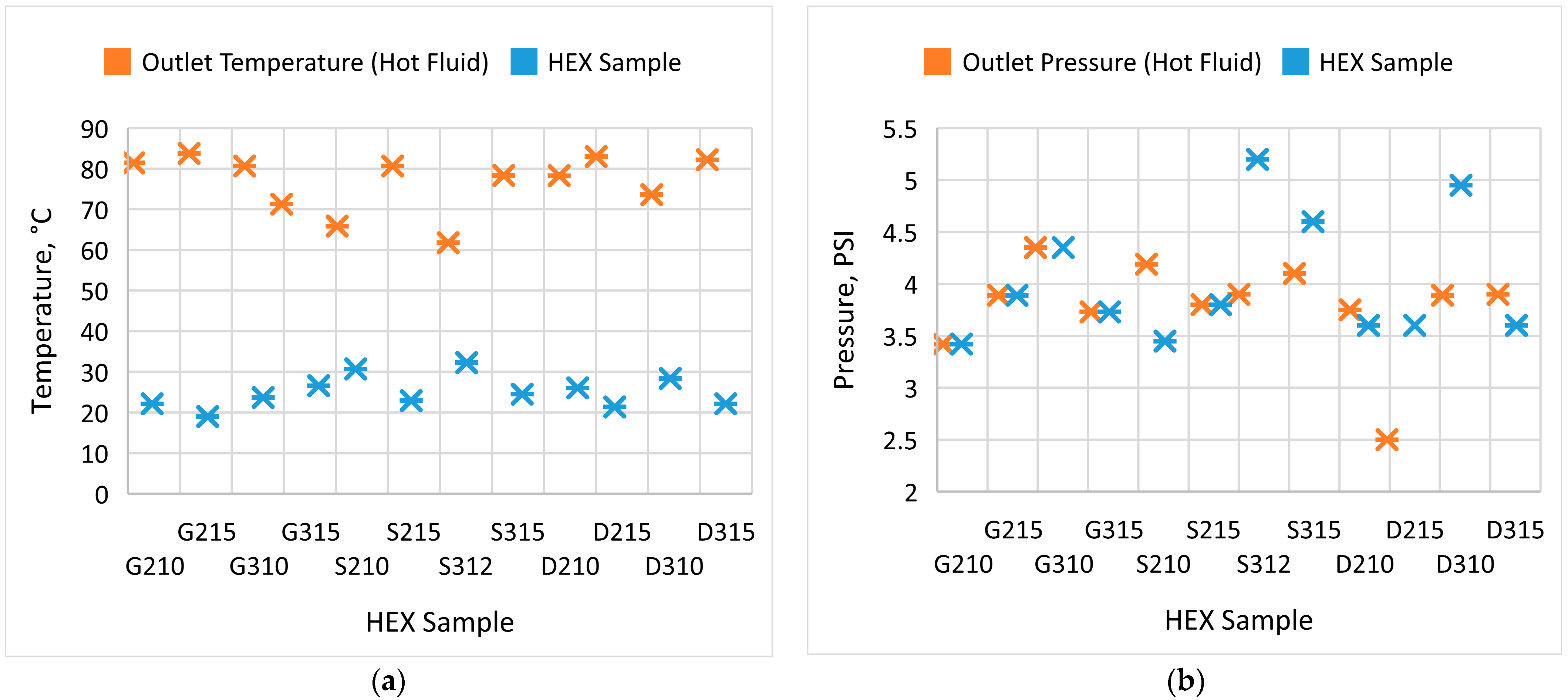Design and Numerical Investigation of High-Performance Heat Exchangers Containing Triply Periodic Minimal Surface Lattice Structures †
Abstract
1. Introduction
2. Design of the Lattice Structure Parametric Model
3. Numerical Investigation
3.1. Exporting Mesh from nTop
3.2. Importing Mesh to Ansys and Generating Volume Mesh
3.3. Heat Transfer Analysis
4. Results and Discussion
4.1. Heat Transfer Against Different Lattic Types, Sizes, and Wall Thicknesses
4.2. Comparative Analysis of the Outlet Temperature and Pressure from Different HEX Samples
5. Conclusions
Author Contributions
Funding
Institutional Review Board Statement
Informed Consent Statement
Data Availability Statement
Conflicts of Interest
References
- Almonti, D.; Ucciardello, N. Design and Thermal Comparison of Random Structures Realized by Indirect Additive Manufacturing. Materials 2019, 12, 2261. [Google Scholar] [CrossRef] [PubMed]
- Li, Y.; Wang, Y.; Du, C. Performance Simulation of Plate Heat Exchanger Based on ANSYS ICEM. In Proceedings of the 2020 6th International Conference on Advances in Energy, Environment and Chemical Engineering, Jinan, China, 19–21 June 2020. [Google Scholar] [CrossRef]
- Almonti, D.; Mingione, E.; Tagliaferri, V.; Ucciardello, N. Design and analysis of compound structures integrated with bio-based phase change materials and lattices obtained through additive manufacturing. Int. J. Adv. Manuf. Technol. 2022, 119, 149–161. [Google Scholar] [CrossRef]
- Pamuk, M.T. CFD Simulation of a Shell and Tube Heat Exchanger. In Proceedings of the 6th World Congress on Mechanical, Chemical, and Material Engineering (MCM’20), Virtual Conference, 16–18 August 2020. [Google Scholar]
- Sakib-Uz-Zaman, C.; Khondoker, M.A.H. A Review on Extrusion Additive Manufacturing of Pure Copper. Metals 2023, 13, 859. [Google Scholar] [CrossRef]
- Reynolds, B.W.; Fee, C.J.; Morison, K.R.; Holland, D.J. Characterisation of Heat Transfer within 3D Printed TPMS Heat Exchangers. Int. J. Heat Mass Transf. 2023, 212, 124264. [Google Scholar] [CrossRef]
- Lai, X.; Wang, C.; Peng, D.; Yang, H.; Wei, Z. Analysis of Heat Transfer Characteristics of a Heat Exchanger Based on a Lattice Filling. Coatings 2021, 11, 1089. [Google Scholar] [CrossRef]
- Battaglia, F.; Arie, M.; Zhang, X.; Ohadi, M.; Shooshtari, A. Experimental Characterization of an Additively Manufactured Inconel 718 Heat Exchanger for High-Temperature Applications. Energies 2023, 16, 4156. [Google Scholar] [CrossRef]
- Sakib-Uz-Zaman, C.; Khondoker, M.A.H. Polymer-Based Additive Manufacturing for Orthotic and Prosthetic Devices: Industry Outlook in Canada. Polymers 2023, 15, 1506. [Google Scholar] [CrossRef] [PubMed]
- Lebaal, N.; SettaR, A.; Roth, S.; Gomes, S. Conjugate heat transfer analysis within in lattice-filled heat exchanger for additive manufacturing. Mech. Adv. Mater. Struct. 2022, 29, 1361–1369. [Google Scholar] [CrossRef]
- Röver, T.; Kuehne, M.; Bischop, F.; Clague, L.; Bossen, B.; Emmelmann, C. Design and numerical assessment of an additively manufactured Schwarz diamond triply periodic minimal surface fluid-fluid heat exchanger. J. Laser Appl. 2023, 35, 042071. [Google Scholar] [CrossRef]
- Strobel, M.; Mortean, M.V.V. Pressure drop and fluid maldistribution analysis of a compact heat exchanger manufactured by 3D printing. Int. J. Therm. Sci. 2022, 172, 107331. [Google Scholar] [CrossRef]
- Li, B.-H.; Chota Castillo, Y.E.; Chang, C.-T. An improved design method for retrofitting industrial heat exchanger networks based on Pinch Analysis. Chem. Eng. Res. Des. 2019, 148, 260–270. [Google Scholar] [CrossRef]





| HEX ID | Lattice Types | Wall Thickness | Unit Cell Size (L = W = H) |
|---|---|---|---|
| G210 | Gyroid | 2 | 10 |
| G215 | Gyroid | 2 | 15 |
| G310 | Gyroid | 3 | 10 |
| G315 | Gyroid | 3 | 15 |
| S210 | SplitP | 2 | 10 |
| S215 | SplitP | 2 | 15 |
| S312 | SplitP | 3 | 12 |
| S315 | SplitP | 3 | 15 |
| D210 | Diamond | 2 | 10 |
| D215 | Diamond | 2 | 15 |
| D310 | Diamond | 3 | 10 |
| D315 | Diamond | 3 | 15 |
| HEX Sample | Outlet Temperature of Hot Fluid (°C) | Outlet Temperature of Cold Fluid (°C) | Outlet Pressure of Hot Fluid (PSI) | Outlet Pressure of Cold Fluid (PSI) |
|---|---|---|---|---|
| G210 | 81.42 | 22.14 | 3.42 | 3.42 |
| G215 | 83.76 | 19.01 | 3.89 | 3.89 |
| G310 | 80.64 | 23.7 | 4.35 | 4.35 |
| G315 | 71.27 | 26.62 | 3.73 | 3.73 |
| S210 | 65.86 | 30.72 | 4.19 | 3.45 |
| S215 | 80.64 | 22.92 | 3.8 | 3.8 |
| S312 | 61.76 | 32.27 | 3.9 | 5.2 |
| S315 | 78.32 | 24.49 | 4.1 | 4.6 |
| D210 | 78.3 | 26.04 | 3.75 | 3.6 |
| D215 | 82.98 | 21.35 | 2.5 | 3.6 |
| D310 | 73.6 | 28.38 | 3.89 | 4.95 |
| D315 | 82.2 | 22.14 | 3.9 | 3.6 |
Disclaimer/Publisher’s Note: The statements, opinions and data contained in all publications are solely those of the individual author(s) and contributor(s) and not of MDPI and/or the editor(s). MDPI and/or the editor(s) disclaim responsibility for any injury to people or property resulting from any ideas, methods, instructions or products referred to in the content. |
© 2024 by the authors. Licensee MDPI, Basel, Switzerland. This article is an open access article distributed under the terms and conditions of the Creative Commons Attribution (CC BY) license (https://creativecommons.org/licenses/by/4.0/).
Share and Cite
Dam, S.; Khondoker, M.A.H. Design and Numerical Investigation of High-Performance Heat Exchangers Containing Triply Periodic Minimal Surface Lattice Structures. Eng. Proc. 2024, 76, 76. https://doi.org/10.3390/engproc2024076076
Dam S, Khondoker MAH. Design and Numerical Investigation of High-Performance Heat Exchangers Containing Triply Periodic Minimal Surface Lattice Structures. Engineering Proceedings. 2024; 76(1):76. https://doi.org/10.3390/engproc2024076076
Chicago/Turabian StyleDam, Sanjoy, and Mohammad Abu Hasan Khondoker. 2024. "Design and Numerical Investigation of High-Performance Heat Exchangers Containing Triply Periodic Minimal Surface Lattice Structures" Engineering Proceedings 76, no. 1: 76. https://doi.org/10.3390/engproc2024076076
APA StyleDam, S., & Khondoker, M. A. H. (2024). Design and Numerical Investigation of High-Performance Heat Exchangers Containing Triply Periodic Minimal Surface Lattice Structures. Engineering Proceedings, 76(1), 76. https://doi.org/10.3390/engproc2024076076







